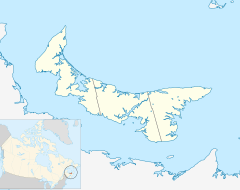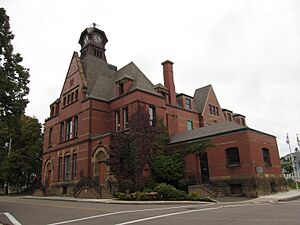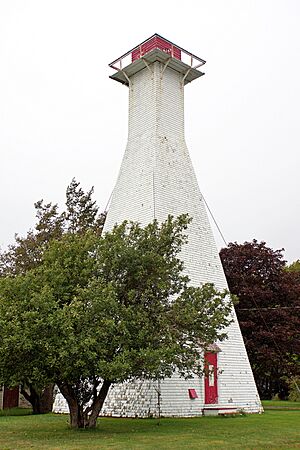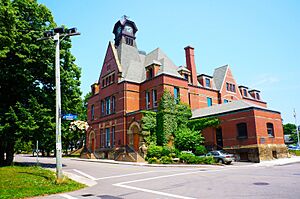List of historic places in Summerside, Prince Edward Island facts for kids
Summerside, a lovely city in Prince Edward Island, Canada, is full of interesting history! Many buildings and places here are considered historic places. This means they are special because of their age, their unique architecture, or important events that happened there. These places are officially recognized on the Canadian Register of Historic Places, which helps protect them for future generations to enjoy and learn from.
Contents
What Makes a Place Historic?
A historic place is more than just an old building. It's a place that tells a story about the past. It could be a house where an important person lived, a church that has been a community hub for over a hundred years, or even a public building like a post office or city hall that shows how people lived and worked long ago.
- Federal Historic Places: These are places recognized by the Canadian government as important to the history of all of Canada.
- Provincial Historic Places: These are important to the history of Prince Edward Island.
- Municipal Historic Places: These are special to the city of Summerside itself.
Protecting these places helps us remember and understand our past. It's like a giant history book you can walk through!
Exploring Summerside's Historic Gems
Summerside has many buildings and sites that have been officially recognized for their historical value. Here are a few examples of places you might see:
Summerside City Hall
The Summerside City Hall is a very important building. It's where the city's government works, but it also has a rich history. The building you see today was originally built as the Post Office and Customs House in 1887. It became the City Hall in 1922. It's a great example of Victorian architecture.
Summerside Law Courts
The Summerside Law Courts, also known as the Prince County Courthouse, is another significant building. It was built in 1876 and is a beautiful example of the architecture from that time. It has served as a place for justice for over a century.
Summerside Back Range Light
Lighthouses and range lights are super important for guiding ships safely. The Summerside Back Range Light is a historic structure that helped sailors navigate the waters around Summerside. It's a reminder of the city's connection to the sea and its past as a busy port.
Former Summerside Post Office
This building, now part of the City Hall, was once the main post office for Summerside. Post offices were central to communities, connecting people through letters and packages. This site is recognized as a National Historic Site of Canada, meaning it's important to the history of the entire country.
Other Notable Historic Buildings
Many other houses and buildings throughout Summerside are also recognized as historic. These include:
- The Lefurgey Cultural Centre: This building, located at 205 Prince Street, is a hub for arts and culture in Summerside and has its own historical significance.
- The MacLennan-Hunt House: Found on Fitzroy Street, this house is recognized for its historical importance to the community.
- The PEIR Armoury: This site on Summer Street was once an armoury for the Prince Edward Island Regiment, playing a role in military history.
- Trinity United Church: Located at 90 Spring Street, this church has been a place of worship and community gathering for many years.
- The Wyatt Historic House: Situated at 85 Spring Street, this house offers a glimpse into the lives of past residents of Summerside.
These places, along with many others like the Lucas Allen House, Stephen Baker House, and various homes on Central, Spring, and Water Streets, all contribute to the unique historical character of Summerside. They remind us of the people who built this city and the way life used to be.
Why Protect These Places?
Protecting historic places is really important for several reasons:
- Learning History: They teach us about how people lived, worked, and built communities in the past.
- Community Pride: They give Summerside a special identity and make it unique.
- Tourism: Historic sites attract visitors, which helps the local economy.
- Sustainability: Reusing old buildings is often more environmentally friendly than building new ones.
By preserving these historic places, we ensure that their stories continue to be told for many years to come.
Images for kids
See also








